
What is a Sports Car Club of America RallyCross?
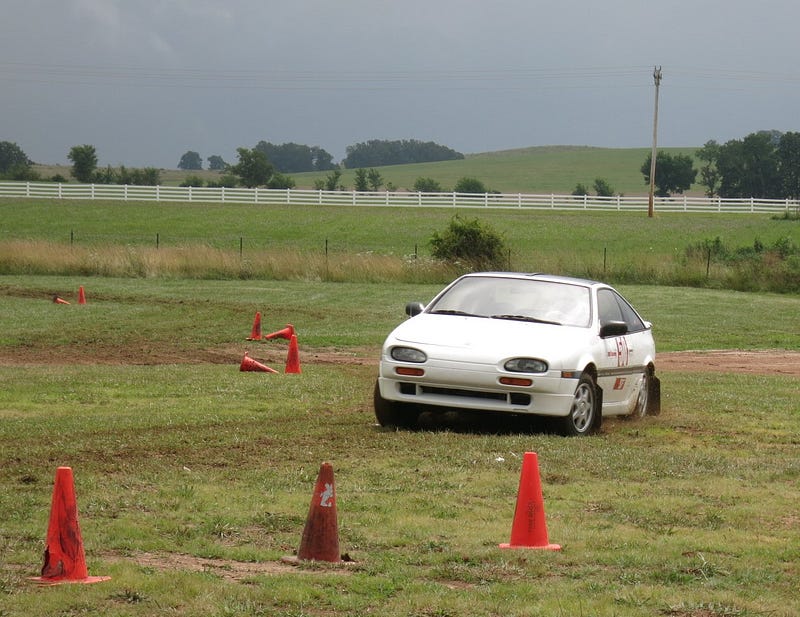 A SCCA RallyCross is a test of driving skill on a temporary unpaved competition course marked by cones. We find an agreeable field owner, lay out a circuit less than a mile long, and take turns trying to set the lowest times. It’s the most affordable way to get a taste of performance rally, and you and all your friends are invited to compete. This guide will walk you through the basics of getting involved.
A SCCA RallyCross is a test of driving skill on a temporary unpaved competition course marked by cones. We find an agreeable field owner, lay out a circuit less than a mile long, and take turns trying to set the lowest times. It’s the most affordable way to get a taste of performance rally, and you and all your friends are invited to compete. This guide will walk you through the basics of getting involved.
Unlike European-style rallycross (lowercase 'c'), cars negotiate the course one at a time and no special roll cage is required. Jumps, walls, and other obstacles are prohibited, so most passenger cars like the one in your driveway are ready to compete. No navigator, just you against the clock.
If you are familiar with autocross, just add dirt and you get the picture. Courses are a little more open and speeds are a little lower that autocrosses, but the emphasis on accessibility, safety, affordability, and fun is the same as SCCA Solo. The key differences are that every run counts towards your total time, and that sliding is a given.
Is it Safe?
RallyCross is designed to be a legal, low-risk time trial at speeds typically 50 MPH or less. Rather than emphasize raw speed, RallyCross offers an intense driving experience that rewards skilled car control on a twisty course. The potential for damage is kept to a minimum, thus allowing a variety of drivers and cars to participate at low cost.
What Kind of Car Do I Need?
No special rally car is needed. Any factory hardtop vehicle passing a basic safety inspection is fine, so your daily-driven sedan on street tires is perfect for Rallycross. For safety reasons, rollover-prone vehicles such as SUVs, 4x4's, and many full-sized trucks may not be allowed to compete. SCCA insurance does not currently allow side-by-sides, homebrew buggies, ATVs, or anything like that. If you have any questions about the eligibility of your vehicle, contact an event official before the day of the event.
Our rule: A RallyCross event is open to any fixed-roof production based vehicle (including convertibles with a factory hardtop attached, targa types with factory panel in place, t-tops with factory panels in place) that can pass safety inspection. If the Event Chairman after consultation with the Event Safety Steward determines at his discretion that a vehicle cannot safely negotiate the course, it may be excluded.
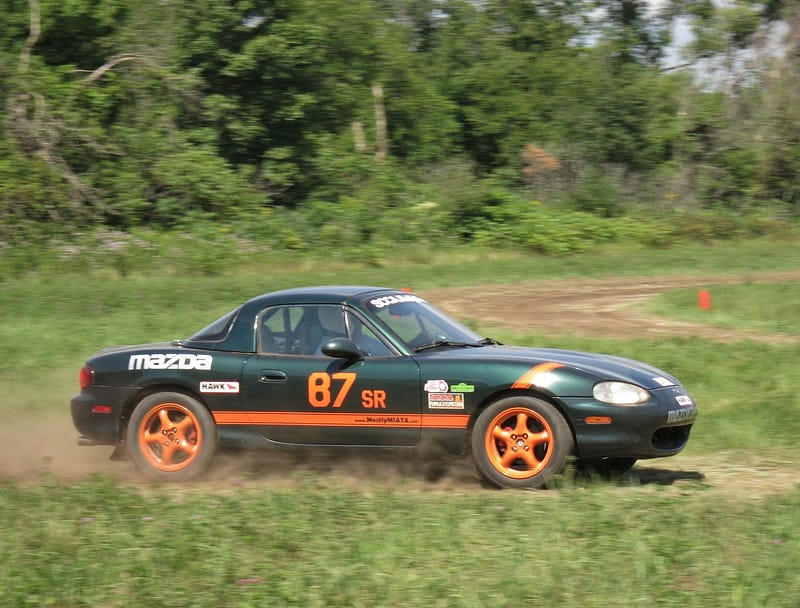
Get Ready
Prepare for Weather
RallyCrosses can happen in everything from snow to hot, dusty Summer days, so be ready for the outdoors in all conditions. Only lightning nearby or dangerous storms can halt the action mid-event. Torrential rain before an event may cause it to be postponed so that we don't leave the property owner with excessive ruts (it's something we announce that ahead of time). Otherwise, it's game on. Wear close-toed shoes and dress in layers, and don't forget winter gear, shorts, ponchos, or sunscreen as the forecast demands. Water is often made available, but bringing extra never hurts. Bug spray and a spare pair of shoes is also a bright idea.
Many RallyCross events are held outside of town, so lunch break may be nothing more than eating your sack lunch between run session, or it may be a 45-minute break if food is available nearby. Watch event announcements and pack accordingly.
Prepare Your Car
Street tires typically need a lot more air than normal to prevent sidewall flex, often an additional 10psi or more. An air tank and quality air gauge is a good investment, as an under-inflated tire can roll over and lose pressure under hard cornering. A regularly maintained, stock-height car should have no trouble surviving a RallyCross, which makes it great for trying it out in the family sedan. Dust and dirt are a certainty - you'll kick up plenty. No points will be awarded for cleanliness.

For a full list of items to bring, read this handy packing list.
Your First RallyCross
When You Arrive
At the entrance station, sign the safety wavier and get an armband. If you have guests joining you, make sure they also stop here to sign the waiver, even if they are not competing. After that, you will register and pay, and we'll give your car a brief safety check. If you pre-registered online via the link in the event announcement, your information is already in the system and that will save a lot of time for you and the volunteers running the event.
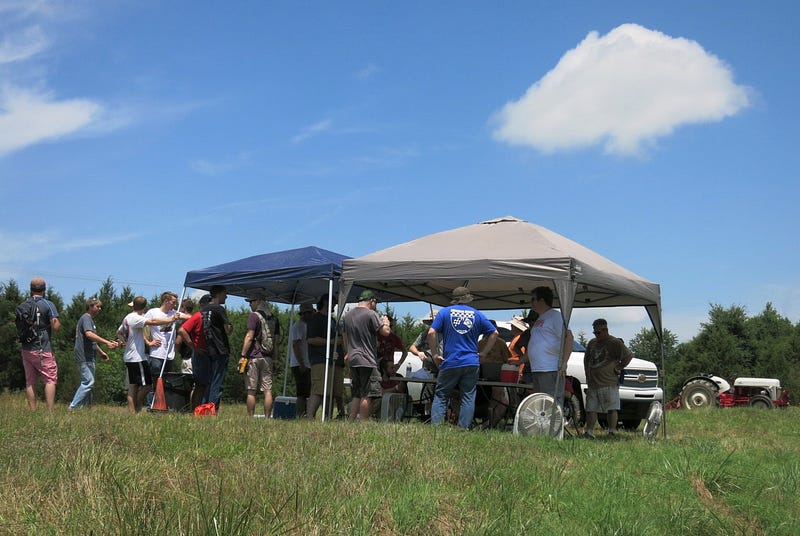
Unload anything not safely secured to the car. This usually includes the spare tire, jack, floor mats, subwoofer, or anything loose that could move around while on course. Open the hood and trunk, and a tech inspector will confirm that your car is sound enough to participate. This will include checking for things like a secured battery and wheel bearings that aren't wobbly, among others.
Registration will ask you for your driver's license, SCCA card (if an annual member), and collect your entry fee. If you are not a SCCA member, you will fill out a SCCA weekend membership form good for five days of club membership and a discount on annual membership. Here they will also enter your class and number in the timing computer, and sign you up for a work assignment. No one likes work, but someone has to keep the event running while the other half race. Watching cars on course as a corner worker is a very good way to see how to go faster. If you are new to the sport, just say so and we'll help you stay on track.
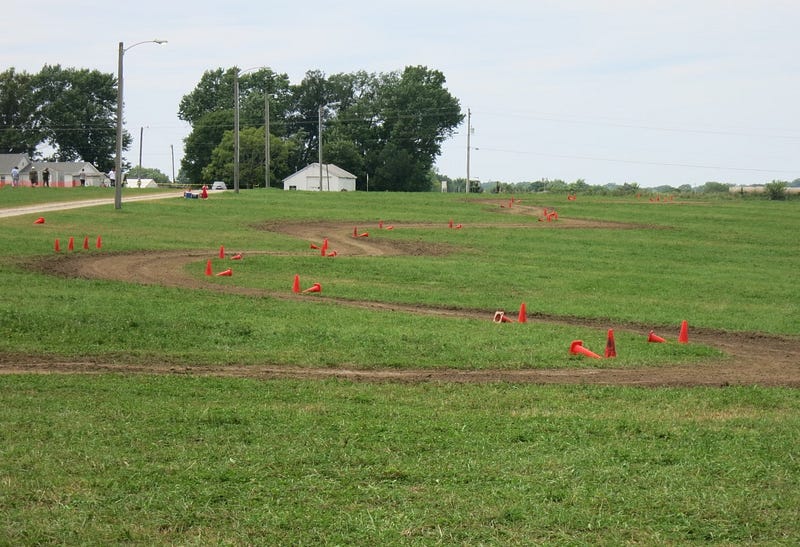
After registration is an excellent time to go walk the course and get to know the path you will be driving. If in doubt, follow others around the course and don't hesitate to ask for directions. Right before your turn to compete, you will get to drive the course at slow speeds on a parade lap.
Competition Time
A drivers' meeting is held a few minutes before the start of competition, and all entrants must attend. The event chairman will cover announcements, the day's schedule, number of runs, standards of conduct, and how to work a corner station. Once the meeting is over, you will either be preparing to race or work, depending on how you were signed up at registration.
If it is your "heat" to race, pull your car to the grid or start line area where cars are staged between runs. Be ready with helmet and seat belt in place. The starter will hold you until it's your turn, and then it's up to you!
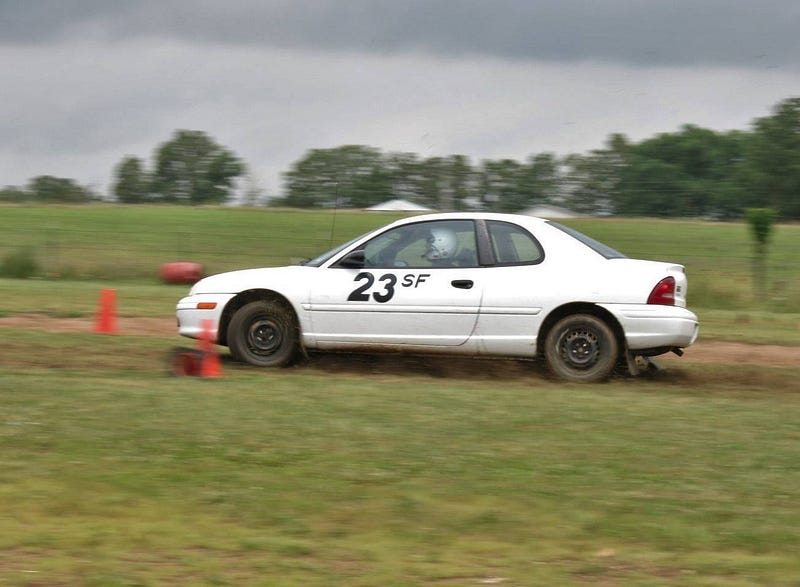
When you're done and pulling off course, remember to slow it back down to a walking pace as you pull back to your grid spot. If you are using a loaner helmet, don't forget to return it after every run so that they are available to share.
End of the Day
At the end of all heats, extra help is always appreciated. Cones need to be stacked, driven back to the trailer, and loaded up. After that, results are announced and trophies are given to the top third in class.
Remember to get back into "street" mode at the end of the day. Burnouts, donuts, street racing, and speeding near the site attract unwanted attention. Help the host region keep the site, and you will be able to enjoy your next RallyCross event, too.
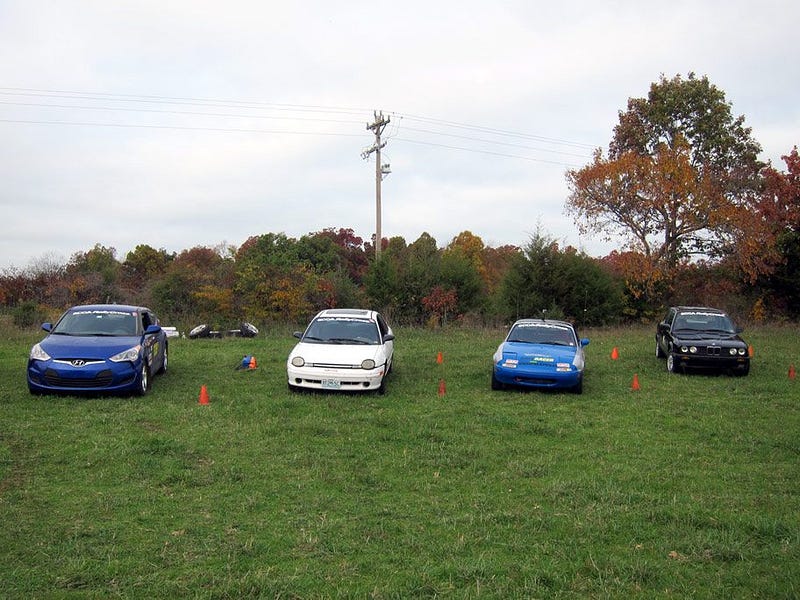
About Classing
All vehicles are grouped with other cars with similar levels of performance and modification for purposes of timing and scoring. As mentioned before, this sport is currently only for production cars.
Competition Categories
- Stock - very close to how the car rolled off the showroom floor. Only DOT-approved street tires such as all-season or snow tires. Mud flaps and skid plates allowed if you like.
- Prepared - limited suspension and bolt-on power upgrades. Stage rally tires allowed. One limited slip differential may modified.
- Modified - engine swaps, gutted interiors, etc.
Each category is then divided by drivetrain type: FWD, RWD, or AWD. Take the first letter of the category and the drivetrain type, and that's your class. A Stock FWD car would be "SF," while a modified AWD car would be "MA." You got it.
How is my car classed?
The full SCCA RallyCross Rulebook is online in Adobe Acrobat (.PDF) format at SCCA.com. Make sure you read Section #6, which contains the classing allowances and safety rules. If you have any questions, ask an event official beforehand and they can probably steer you in the right direction.
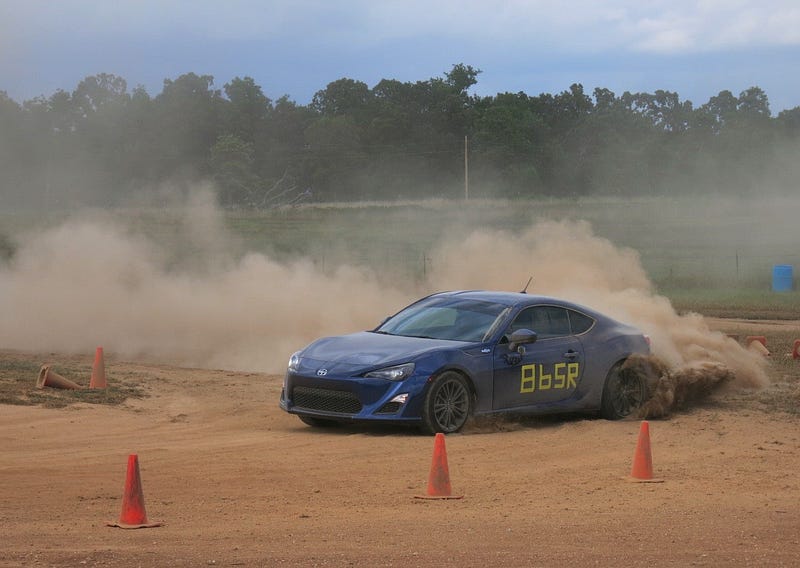
For a new RallyCrosser, the main thing to remember is to learn and have fun. "Competitiveness" can wait, so don't worry about who or what is in your class. RallyCross is a traction-limited sport, so you might be surprised how much the driver figures into the equation, not the car.
Your car will need numbers and class letters on the side of the car so that course workers can identify you. The SCCA minimum is numbers 8" tall with 1.25" stroke (thickness) and class letters 4" tall with 0.75" stroke. You can make visibly large numbers and letters out of painter's tape in a contrasting color. However, tape can be hard to see, so we recommend buying a magnetic number set or a sheet of magnetic material (or static cling for composite bodies).
Learning Curve
Course Walking
Walking the course is an often underestimated part of learning the sport and getting faster. Always err on the side of arriving early so you have plenty of time to walk the course multiple times. In the beginning, just knowing where it goes seems like a challenge. Don't hesitate to ask someone in the know about a confusing section.
As a rule of thumb, if you can't run the course in your mind or the draw the general path on a piece of paper, you should walk it again. Help your memorization by narrowing down the cones out there to just the important ones. Many cones just set boundaries or provide direction, so pick out which ones you want to be looking for when you're driving at speed.
Tires
Other than driver skill, tires are the single most important investment you can make for RallyCross. Many drivers have a second set of wheels and tires just for competition use. The Stock category does have limits on wheel size and tire type, so check the rules before you make an investment
The most effective upgrade is snow tires, which are allowed in all the classes. They are softer compound than regular all-season street tires and typically have more aggressive tread blocks, both of which help the car get traction in every direction. More forward bite also offers more acceleration, which lets you experiment with momentum maintenance though the turns (aka sliding).
Prepared and Modified also allow stage rally tires, which feature stiffened sidewalls and choices of temperature compounds based on the weather. They are more limited in size options compared to snow tires, and may be more difficult to find and buy. More experienced RallyCrossers will seek these tires to fine-tune their traction at upper-level events. Snow tires still offer similar traction and fun, though.
The "Best" Car for RallyCross

If your passenger car has adequate ground clearance (no lowering springs or low-hanging spoilers), whatever you already have should be fine. All cars are grouped into classes of same drivetrain type (FWD, RWD, or AWD), each with its own brand of skills and fun.
A rally-inspired turbo AWD car is very potent for RallyCross, but not mandatory to have a blast. Many of our lowest times are set by drivers in low-horsepower 2WD cars. Front-wheel-drive sport compacts such as Neons, Civics, Sentras, etc., are especially popular because they are affordable, light, and offer a stable platform to execute the small, controlled slides that maximize momentum though turns. A small RWD car like a Miata (with factory hardtop, obviously) is another popular way to get a kick out of RallyCross, as grappling with oversteer is part of the experience.
The Next Level
RallyCross Event Types
- Regional: Your local events are held at the "regional" level. A single region such as Ozark Mountain Region or Kansas City Region will host the event. Anyone from anywhere is welcome to attend, but most entrants are located within a few hours' drive. Many competitors enjoy visiting events outside their home region, as well.
- Divisional: SCCA regions are grouped into one of eight divisions. For example, Ozark Mountain Region mentioned above is a part of Midwest Division (a.k.a. MiDiv). Divisions may host a single divisional championship, or a series of events. Entrants typically come from that part of the country. These offer a larger, more competitive field of drivers while maintaining much of the laid-back social atmosphere of a regional event.
- National Challenge: Several locations in America will host a two-day National Challenge that attracts SCCA members from an even larger area. Higher levels of competition, plus modest sponsor contingency payouts are on the table.
- RallyCross National Championships: The most active competitors from around America come together annually to crown the best driver in each class over a multi-day competition. Any SCCA member is allowed to attend, but be prepared for close battles at the front of each class. RallyCross Nationals is frequently held within in our centrally located Midwest Division, which is a convenient opportunity to make friends and find competition from all over the club.
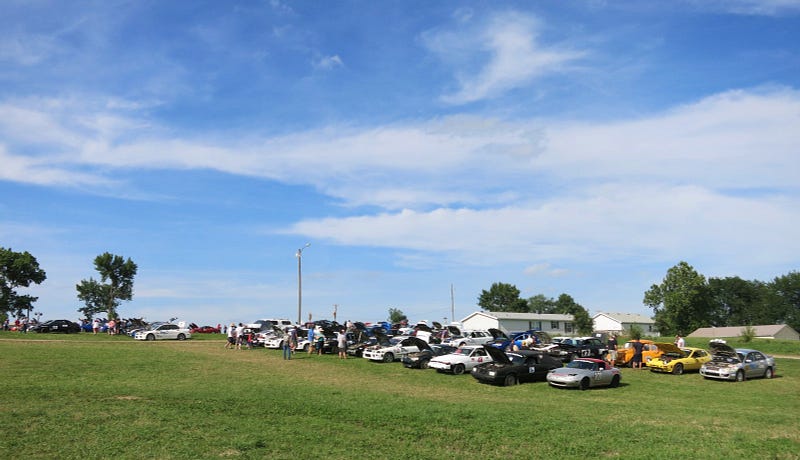
Video Roll
While you’re getting ready for the next RallyCross, whet your appetite with a few of your author’s video favorites:
- “What is RallyCross?” A promotional video from Colorado RallyCross.
- 2011 SCCA Rallycross National Championships video montage.
- Highlight reel from 2015 Ozark Mountain Region RallyCross #2.
Article and photos by Jim Rowland, Midwest Division RallyCross Steward














